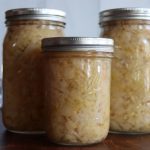Canning Sauerkraut
Easy instructions for fermenting and canning homemade sauerkraut.
Servings: 112 servings, Makes 9 (1-quart) jars
Ingredients
- 25 lbs cabbage whole
- 3/4 cup pickling salt or canning salt or kosher salt
Instructions
- Working with 5 pounds of cabbage at a time, remove outer leaves and carefully wash each cabbage. Quarter and core each cabbage.
- Using a sharp knife, mandolin, or food processor with shredded attachment, shred the cabbage into thin ribbons the thickness of a quarter.
- Pack shredded cabbage into a fermentation crock.
- Add 3 tablespoons of canning/pickling salt to the cabbage in the crock and mix together with clean hands. (You'll need about 3 tablespoons for every 5 lbs of cabbage, so keep adding in 3 tbsp increments for each 5lb batch you work thoroughly.)
- Using a fermentation pounder or wooden spoon, pack the shredded and salted leaves tightly into the crock. Leave 4 to 5 inches of space at the top.
- Repeat this process with the remaining cabbage and salt, packing it into each fermentation crock. The salt will work to draw liquid from the cabbage, which should be submerged in this natural brine after a couple of hours.
- Cover the cabbage with your choice of fermentation weights so that it is entirely covered by liquid.
- Allow the sauerkraut to ferment over 3 to 6 weeks, depending on the ambient temperature around the crock and how strong you like your sauerkraut. Colder temperatures mean the fermentation process will be slower, warmer temperatures can speed the process up. Do a taste test frequently to check on the fermentation process.
- If at any point you notice the liquid level decreasing, cover the sauerkraut with fresh, unchlorinated water to keep the sauerkraut below the brine level.
- The total fermentation time depends on your preference, but it should ferment at least 4 weeks at room temperature (68 to 72 degrees) to be acidic enough for canning (see notes). Most people opt for around 6 weeks for best flavor. When the sauerkraut is to your taste preference, it can be preserved using either a raw pack or a hot pack.
- Raw pack method: fill each prepared quart jar with sauerkraut and its liquid (make sure the liquid is completely covering the sauerkraut). Leave 1/2-inch of headspace and apply two-part lids until fingertip tight.
- Hot pack method: heat sauerkraut and juices in a large, heavy-bottomed pot until boiling, being sure to stir frequently. Fill prepared quart jars with the hot sauerkraut and liquid. Leave 1/2-inch of headspace and apply two-part lids until fingertip tight.
- Wipe the sides of each jar with a clean cloth and load into a prepared hot water bath canner.
- Process the sauerkraut using the time recommended in the above chart (25 minutes for raw pack, 15 minutes for hot pack). If canning at a higher altitude, take note of longer processing times.
- When the timer goes off, turn off the heat and let the jars sit in the hot water canner for another 5 minutes.
- Carefully remove the jars from the hot water canner using a jar lifter.
- Place the jars on a clean towel, leaving 1-inch of space between each jar, and let the contents come to room temperature (12 to 24 hours).
- Check the seal on each lid, moving any unsealed jars to the refrigerator for storage.
- Remove the band from successfully canned jars of sauerkraut for another use and store in a cool, dry area away from direct light for up to 18 months.
Notes
Be aware that the fermentation process acidifies the sauerkraut, which makes it safe for water bath canning. The sauerkraut will need to be fermented at room temperature for a minimum of 3 to 4 weeks before canning. Do not attempt this recipe with plain cabbage, it is not safe for canning because it is not acidic enough.
According to the Complete Guide to Home Canning from the National Center for Food Preservation, "Sauerkraut fermentation can take place under variable temperature and time combinations. For obtaining a good quality sauerkraut at home, the USDA recommendation is to store at 70º to 75ºF while fermenting. At temperatures between 70º and 75ºF, kraut will be fully fermented in about 3 to 4 weeks; at 60º to 65ºF, fermentation may take 5 to 6 weeks. At temperatures lower than 60ºF, kraut may not ferment. Above 75ºF, kraut may become soft."
Nutrition
Calories: 25kcal | Carbohydrates: 6g | Protein: 1g | Fat: 0.1g | Saturated Fat: 0.03g | Polyunsaturated Fat: 0.02g | Monounsaturated Fat: 0.02g | Sodium: 776mg | Potassium: 172mg | Fiber: 3g | Sugar: 3g | Vitamin A: 99IU | Vitamin C: 37mg | Calcium: 41mg | Iron: 0.5mg
